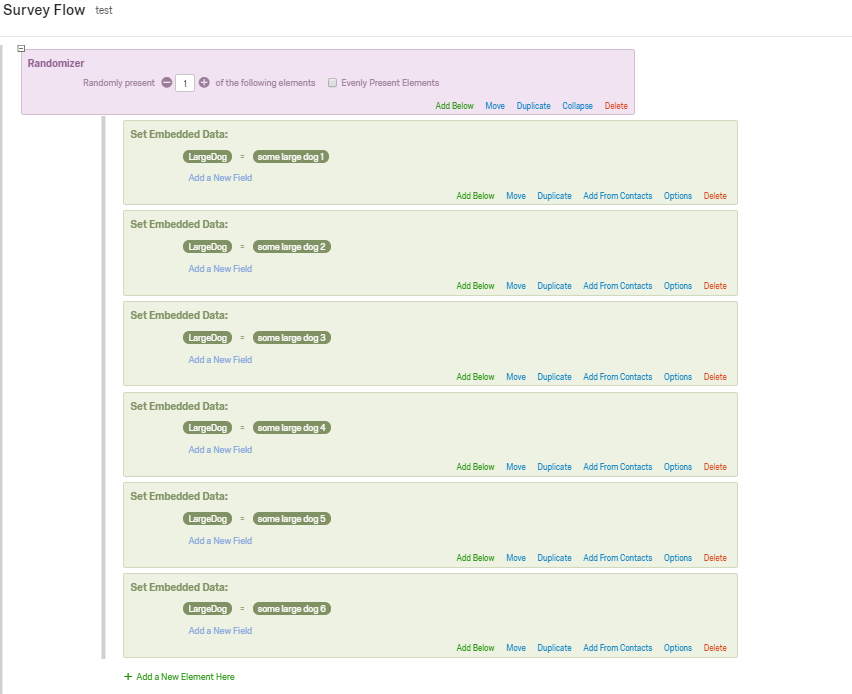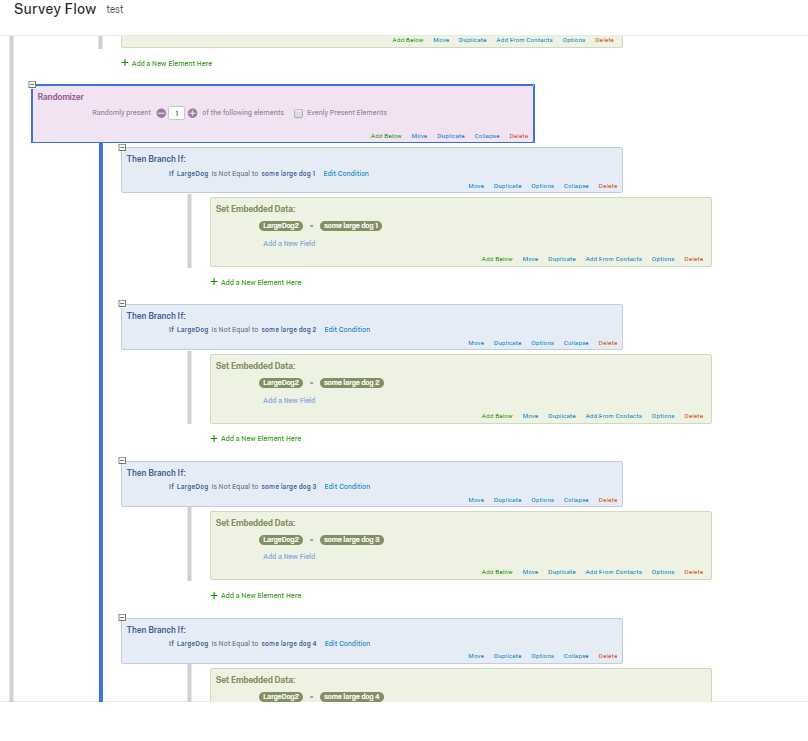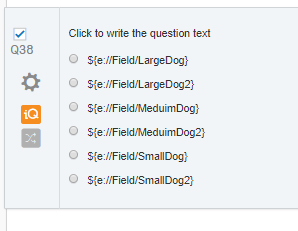Best answer by NiC
View originalNeed to present a limited number of choices from different groups
I have 18 dog breeds from 3 different categories (small, medium and large) and wanted to show in my survey 2 breeds from each category. Does anyone know how to do this?
You can save the options in embedded data
and then use randomizer to get any two out of each of the three breeds.
For eg:
1)For the first option of every category(Done for Large dogs here):
!
2)For the Second option of the same category(Done for Large dogs here):
!
3)Now repeat for other Dog Categories
4)Now Pipe these embedded Data into options (for Randomization among breeds you can select randomize choices here)
!
and then use randomizer to get any two out of each of the three breeds.
For eg:
1)For the first option of every category(Done for Large dogs here):
!

2)For the Second option of the same category(Done for Large dogs here):
!

3)Now repeat for other Dog Categories
4)Now Pipe these embedded Data into options (for Randomization among breeds you can select randomize choices here)
!

hi @annepetti ,
You can use randomization to select 2 breed from each category.
Below link help you use randomization in choice:
https://www.qualtrics.com/support/survey-platform/survey-module/question-options/choice-randomization/
You can use randomization to select 2 breed from each category.
Below link help you use randomization in choice:
https://www.qualtrics.com/support/survey-platform/survey-module/question-options/choice-randomization/
> @NiC_Ugam said:
> You can save the options in embedded data
> and then use randomizer to get any two out of each of the three breeds.
> For eg:
> 1)For the first option of every category(Done for Large dogs here):
> !
> 2)For the Second option of the same category(Done for Large dogs here):
> !
> 3)Now repeat for other Dog Categories
> 4)Now Pipe these embedded Data into options (for Randomization among breeds you can select randomize choices here)
> !
>
>
>
Hi @annepetti
Open the images in new tab to see the conditions clearly, sorry for the small images.
> You can save the options in embedded data
> and then use randomizer to get any two out of each of the three breeds.
> For eg:
> 1)For the first option of every category(Done for Large dogs here):
> !

> 2)For the Second option of the same category(Done for Large dogs here):
> !

> 3)Now repeat for other Dog Categories
> 4)Now Pipe these embedded Data into options (for Randomization among breeds you can select randomize choices here)
> !

>
>
>
Hi @annepetti
Open the images in new tab to see the conditions clearly, sorry for the small images.
@annpetti,
You should put all 18 breeds as choices in your question. You should use three survey flow randomizers to set a breed flag to 1 for two breeds in each group. Then add display logic to each of the choices in your question to display the breed if the breed flag is 1.
@NiC_Ugam's solution would work, but the resulting data would be messy. @PraDeepKotian_Ugam's solution won't work (you can't randomly select two from each group using Advanced Randomization and group randomization doesn't have the ability to randomly select subsets)
You should put all 18 breeds as choices in your question. You should use three survey flow randomizers to set a breed flag to 1 for two breeds in each group. Then add display logic to each of the choices in your question to display the breed if the breed flag is 1.
@NiC_Ugam's solution would work, but the resulting data would be messy. @PraDeepKotian_Ugam's solution won't work (you can't randomly select two from each group using Advanced Randomization and group randomization doesn't have the ability to randomly select subsets)
Leave a Reply
Enter your username or e-mail address. We'll send you an e-mail with instructions to reset your password.





